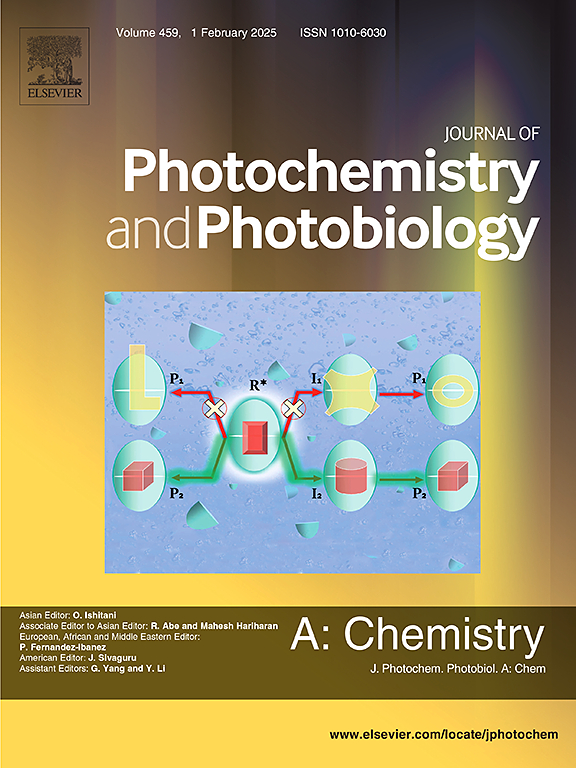uv -可见光下Ta、V、nb掺杂TiO2光催化和电催化降解对硝基苯酚的优化研究
IF 4.1
3区 化学
Q2 CHEMISTRY, PHYSICAL
Journal of Photochemistry and Photobiology A-chemistry
Pub Date : 2025-04-23
DOI:10.1016/j.jphotochem.2025.116453
引用次数: 0
摘要
本研究的目的是研究通过掺杂钽(Ta)、钒(V)或铌(Nb)前驱体来增强TiO2在紫外/可见光和可见光下的光催化活性。因此,二氧化钛基光催化剂是在室温下通过水溶胶-凝胶合成制备的。这些光催化剂中掺杂了不同摩尔比的掺杂剂。利用各种互补技术表征了所得到的光催化剂的物理化学性质。采用x射线衍射(XRD)测定样品中TiO2不同晶相的分布及非晶态TiO2的比例。BET测量显示其比表面积高达292 m2/g的纹理特性,TEM图像显示其球形形貌。电感耦合等离子体原子发射光谱(ICP-AES)、能量色散x射线光谱(EDX)和x射线光电子能谱(XPS)分析证实了样品中存在Ti、O和Ta、V或Nb元素。此外,XPS光谱显示了未掺杂的合成TiO2中氮的掺入。此外,通过紫外-可见漫反射光谱(DRUS)测量带隙宽度来观察掺杂剂对带隙的影响,其中v掺杂将其值从2.95 eV降低到1.88 eV。通过对紫外光-可见光(300 <;λ& lt;800 nm)和可见光(395 <;λ& lt;800海里)。该研究表明,光催化活性受掺杂物的性质和含量的显著影响。光催化测试表明,掺杂钽和铌后,光催化剂的活性有所提高(在可见光下,未掺杂TiO2的活性为22%,掺杂Ta和nb的活性分别为37%和55%),而掺杂钒的活性则显著降低(掺杂v的活性降至3 - 12%)。最后,实现了一个初步的光电催化实验装置,并且与未涂覆阳极相比,当阳极涂覆了最好的掺杂tio2材料(Nd掺杂)时,PNP溶液的矿化程度有所改善(矿化率从72%增加到94%)。本文章由计算机程序翻译,如有差异,请以英文原文为准。

Optimization of Ta-, V-, or Nb-doped TiO2 for photocatalytic and electrophotocatalytic degradation of p-nitrophenol under UV–visible light
The objective of this study is to investigate the enhancement of TiO2 photocatalytic activity under UV/visible and visible light by doping with tantalum (Ta), vanadium (V) or niobium (Nb) precursors. Thus, TiO2-based photocatalysts are prepared at room temperature via aqueous sol–gel synthesis. These photocatalysts are doped with different molar ratios of dopants. The physicochemical properties of the obtained photocatalysts are characterized using various complementary techniques. X-ray diffraction (XRD) is used to determine the distribution of different crystalline phases of TiO2 and the proportion of amorphous TiO2 in the samples. BET measurements give textural properties with specific surface area reaching up to 292 m2/g and TEM images illustrating their spherical morphology. Inductively coupled plasma atomic emission spectroscopy (ICP-AES), energy-dispersive X-ray spectroscopy (EDX), and X-ray photoelectron spectroscopy (XPS) analyses confirmed the presence of Ti, O and Ta, V or Nb elements in the samples. Additionally, XPS spectra highlights the incorporation of nitrogen in the undoped synthesized TiO2. Additionally, band gap widths measured by UV–vis diffuse reflectance spectroscopy (DRUS) are done to see the impact of the dopants on the bandgap, with V-doping reducing its value from 2.95 to 1.88 eV. A screening of the photocatalytic activity of undoped and doped photocatalysts is carried out by evaluating the degradation of p-nitrophenol under UV–visible light (300 < λ < 800 nm) and visible light only (395 < λ < 800 nm). This study suggests that photocatalytic activity is significantly influenced by the nature and dopant content. Photocatalytic tests show an improvement in the activity of the photocatalyst when doped with tantalum and niobium (from 22 % with undoped TiO2 under visible light to 37 % and 55 % with the best Ta and Nb-doped samples respectively), while a notable decrease in activity is observed with vanadium doping (dropping to 3–12 % with the V-doped series). Finally, a preliminary electrophotocatalysis experimental setup is implemented and appears to show an improvement in the mineralization of the PNP solution when the anode is coated with layers of the best doped-TiO2 material (Nd doping), compared to an uncoated anode (the mineralization rate increases from 72 % to 94 %).
求助全文
通过发布文献求助,成功后即可免费获取论文全文。
去求助
来源期刊
CiteScore
7.90
自引率
7.00%
发文量
580
审稿时长
48 days
期刊介绍:
JPPA publishes the results of fundamental studies on all aspects of chemical phenomena induced by interactions between light and molecules/matter of all kinds.
All systems capable of being described at the molecular or integrated multimolecular level are appropriate for the journal. This includes all molecular chemical species as well as biomolecular, supramolecular, polymer and other macromolecular systems, as well as solid state photochemistry. In addition, the journal publishes studies of semiconductor and other photoactive organic and inorganic materials, photocatalysis (organic, inorganic, supramolecular and superconductor).
The scope includes condensed and gas phase photochemistry, as well as synchrotron radiation chemistry. A broad range of processes and techniques in photochemistry are covered such as light induced energy, electron and proton transfer; nonlinear photochemical behavior; mechanistic investigation of photochemical reactions and identification of the products of photochemical reactions; quantum yield determinations and measurements of rate constants for primary and secondary photochemical processes; steady-state and time-resolved emission, ultrafast spectroscopic methods, single molecule spectroscopy, time resolved X-ray diffraction, luminescence microscopy, and scattering spectroscopy applied to photochemistry. Papers in emerging and applied areas such as luminescent sensors, electroluminescence, solar energy conversion, atmospheric photochemistry, environmental remediation, and related photocatalytic chemistry are also welcome.

 求助内容:
求助内容: 应助结果提醒方式:
应助结果提醒方式:


